We have moved locations for our Missouri office, our new location is at 211 N. Lindbergh Blvd., Suite 201 Creve Coeur, MO 63141, excited to see you there!
Condylar Hyperplasia
Condylar Hyperplasia Type I is a medical condition characterized by excessive growth and elongation of the mandibular condyle, which is a part of the lower jaw. This abnormal growth leads to facial asymmetry, a noticeable difference in the length of the two sides of the face.
Condylar Hyperplasia Type I
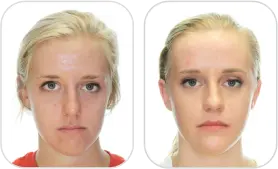
Before
After
Bilateral High Condylectomy. Lefort 1 Segmental Osteotomy. Bilateral Saggital Split Osteotomy.
There was excessive growth in both sides of her jaw joints, and this growth was not symmetrical or balanced. The jaw bones on both sides grew more than they should have leading to an imbalance in their size and shape. After two rounds of orthodontic therapy the excessive growth her jaw joints persisted, resulting in the continued facial asymmetry and the need for surgery.
Condylar Hyperplasia Type II
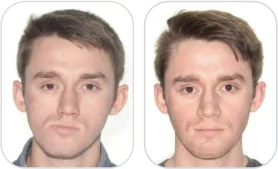
Before
After
Lefort 1 Segmental Osteotomy. Bilateral Saggital Split Osteotomy.
VIDEO INCLUDED
Before the surgery, he was very unhappy with his smile and how asymmetrical his jaw looked. He had a benign tumor called an Osteochondroma on his condyle that caused problems with the alignment of his jaws. Dr. Movahed removed the tumor and fixed the damage it had caused.
Condylar Hyperplasia Type II
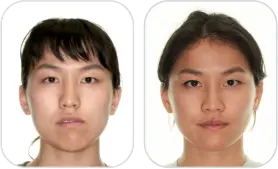
Before
After
Lefort 1 Segmental Osteotomy. Bilateral Sagittal Split Osteotomy. Genioplasty.
VIDEO INCLUDED
She first noticed slight misalignment and difficulty chewing on one side of her mouth, but she didn’t seek treatment right away. Over time, her condition worsened, leading to asymmetry, a crossbite, tension headaches, teeth grinding, and sleep troubles. Seeking a second opinion, she was diagnosed with a benign bone tumor in the right condyle.
Condylar Hyperplasia Type II
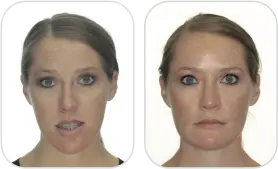
Before
After
Lefort 1 Osteotomy. Bilateral Sagittal Split Osteotomy. Genioplasty.
VIDEO INCLUDED
In high school, she noticed her gum line receding and misalignment in her jaws. Referred to Dr. Movahed, he recommended jaw surgery to address the asymmetry in her lower jaw and small top jaw. Without the surgery, her teeth would have fallen out due to receding gums. After the surgery she experienced an overall increased quality of life.
Condylar Hyperplasia Type II
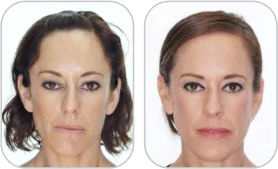
Before
After
Low Condylectomy Lateral Discopexy. Lefort 1 Segmental Osteotomy. Bilateral Sagittal Split Osteotomy.
Condylar Hypoplasia Type 2 is a condition characterized by the unilateral overgrowth of a part of the jaw. Usually caused by a benign tumor called an osteochondroma on one condyle of the mandible.
Condylar Hyperplasia Type II
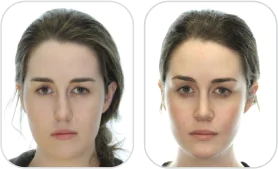
Before
After
Lefort 1 Segmental Osteotomy. Bilateral Sagittal Split Osteotomy. Genioplasty.
Condylar Hypoplasia Type 2 is a condition characterized by the unilateral overgrowth of a part of the jaw. Usually caused by a benign tumor called an osteochondroma on one condyle of the mandible.
Condylar Hyperplasia Type II
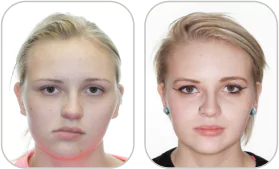
Before
After
Lefort 1 Osteotomy. Bilateral Sagittal Split. Genioplasty.
Condylar Hypoplasia Type 2 is a condition characterized by the unilateral overgrowth of a part of the jaw. Usually caused by a benign tumor called an osteochondroma on one condyle of the mandible.
Condylar Hyperplasia Type II
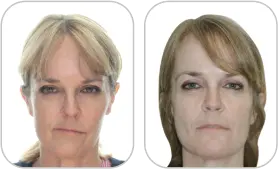
Before
After
Lefort 1 Segmental Osteotomy. Bilateral Total joint Replacement (TJR). Genioplasty.
She had uneven facial appearance that had been getting worse for 7 years. She experienced constant pain on the right side of her face and bone grinding on the left side. These issues made it difficult for her to perform daily activities and eat properly.
Condylar Hyperplasia Type II
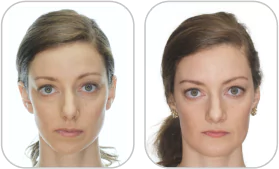
Before
After
Lefort 1 Segmental Osteotomy. Bilateral Total Joint Replacement (TJR). Genioplasty.
VIDEO INCLUDED
During a routine dental appointment, she was informed that she needed surgery. She was surprised because she was not in any pain. Dr. Movahed diagnosed her with mandibular condylar hyperplasia. He performed bilateral jaw joint replacement and employed stabilizers to realign her upper and lower jaw.
Condylar Hyperplasia Type III
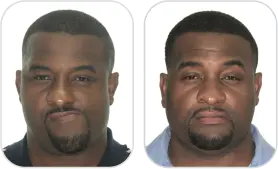
Before
After
Lefort 1 Osteotomy. Bilateral Sagittal Split Osteotomy. Genioplasty.
He was suffering from severe facial asymmetry, jaw deviation, limited jaw movement, malocclusion, difficulty chewing or speaking, pain and discomfort in his jaw joint, clicking and popping sounds, and dental misalignment.
